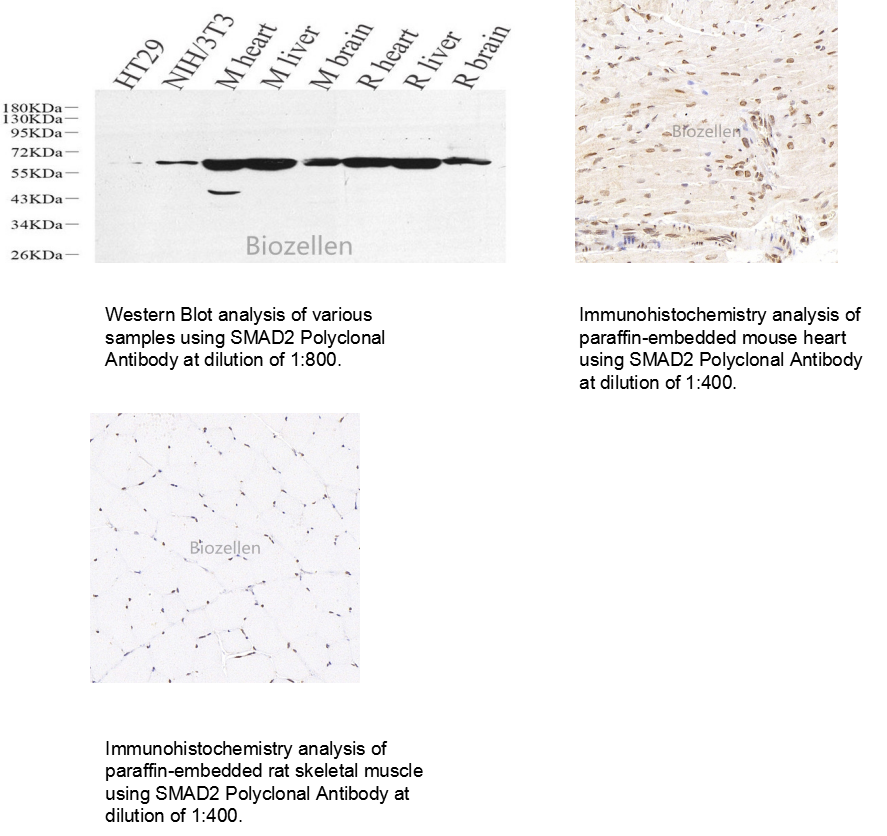| Synonyms | Drosophila,homolog of,MADR2,hMAD-2,HsMAD2,JV18,JV18-1,JV181,MAD,MAD homolog 2,MAD Related Protein 2,Mad-related protein 2,MADH2,MADR2,MGC22139,MGC34440,Mother against DPP homolog 2,Mothers against decapentaplegic homolog 2,Mothers against decapentaplegic,Drosophila,homolog of,2,Mothers against DPP homolog 2,OTTHUMP00000163489,Sma and Mad related protein 2,Sma- and Mad-related protein 2 MAD,SMAD 2,SMAD family member 2,SMAD,mothers against DPP homolog 2,SMAD2,SMAD2 |
| Swissprot | Q15796,Q62432,O70436 |
| Source | Rabbit |
| Reactivity | Human,Mouse,Rat |
| Immunogen | Recombinant protein corresponding to MouseSmad2 |
| Application | WB,IHC |
| Recommended dilution | WB 1:500-1:2000, IHC 1:300-1:800 |
| Concentration | 500 μg/mL |
| Clonality | Polyclonal |
| Cellular localization | Cytoplasm. Nucleus. Cytoplasmic and nuclear in the absence of TGF-beta. On TGF-beta stimulation, migrates to the nucleus when complexed with SMAD4. On dephosphorylation by phosphatase PPM1A, released from the SMAD2/SMAD4 complex, and exported out of the nucleus by interaction with RANBP1. |
| Tissue specificity | Expressed at high levels in skeletal muscle, endothelial cells, heart and placenta.Highest expression level in kidney |
| Isotype | IgG |
| Purification | Affinity purification |
| Conjugation | Unconjugated |
| Storage instructions | Store at -20℃. Avoid freeze / thaw cycles. |
| Storage buffer | PBS with 0.02% sodium azide,100 μg/ml BSA and 50% glycerol. |
| Background | The protein encoded by this gene belongs to the SMAD, a family of proteins similar to the gene products of the Drosophila gene 'mothers against decapentaplegic' (Mad) and the C. elegans gene Sma. SMAD proteins are signal transducers and transcriptional modulators that mediate multiple signaling pathways. This protein mediates the signal of the transforming growth factor (TGF)-beta, and thus regulates multiple cellular processes, such as cell proliferation, apoptosis, and differentiation. This protein is recruited to the TGF-beta receptors through its interaction with the SMAD anchor for receptor activation (SARA) protein. In response to TGF-beta signal, this protein is phosphorylated by the TGF-beta receptors. The phosphorylation induces the dissociation of this protein with SARA and the association with the family member SMAD4. The association with SMAD4 is important for the translocation of this protein into the nucleus, where it binds to target promoters and forms a transcription repressor complex with other cofactors. This protein can also be phosphorylated by activin type 1 receptor kinase, and mediates the signal from the activin. Alternatively spliced transcript variants have been observed for this gene. |
